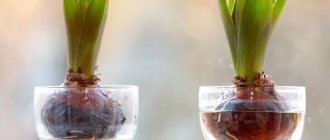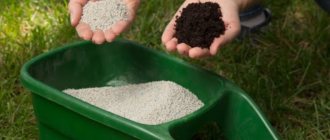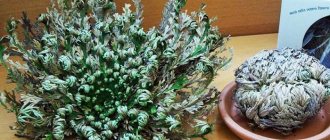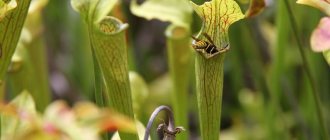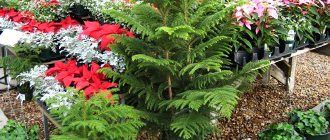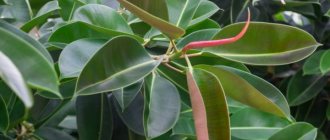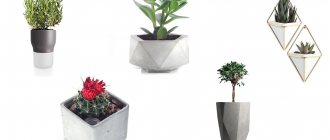Benefit
It is important to remember that plants in a bathroom where there is no window not only convey an aesthetic message, but also bring undeniable benefits:
- in addition to the ability to release oxygen, thereby purifying the air, the flora in the bathroom prevents the formation of fungal formations, normalizes the microclimate, improves water and gas exchange, and absorbs microparticles of heavy metals;
- flowers, with their natural aroma, deodorize the air in a room with or without a window;
- living indoor greenery is a pleasant reminder of summer and helps improve your mood;
- Flora plays an important role in the interior, making it colorful and complete.
From all of the above, the question arises: “can living vegetation grow normally and exist in a bathroom that does not have windows - they can.” There are varieties for which such conditions are the most acceptable and the absence of a window will not be an obstacle to their daily delight with their magnificent view.
Aspidistra
This plant belongs to the evergreen herbs of the Asparagus family. The second name for aspidistra is “snake grass”, due to the exotic appearance of the leaves that do not have stems and resemble a snake.
Aspidistra loves shade and is very unpretentious; it can grow well at a temperature of 10-12 degrees. It is enough to water it periodically, preventing the earthen clod from drying out.
Requirements for plants
Bathroom varieties must have the following characteristics:
- love moisture, warmth;
- not demanding on light;
- should be in harmony with the interior.
In order for bathroom plants to feel good, form, and grow in a humid and warm atmosphere, you need to not only keep them there, but also properly care for them, especially since bathrooms often do not have windows.
Philodendron
This plant has wide, massive leaves on long stems and is sure to brighten up your bathroom. Philodendron loves diffused light, high air humidity and relative coolness (about 15-20 degrees).
This flower needs abundant watering and foliage irrigation. Due to the heaviness of the leaves, the stem of the plant may break off, so the optimal solution would be, as the philodendron grows, to install a decorative support in the pot.
Flowers for a bathroom without windows
Aloe vera
For a windowless bathroom this is an ideal candidate. Large amounts of sunlight are contraindicated for this plant, as it can get burned. Of course, this does not mean that it needs to be kept in complete darkness. Additional illumination of aloe is necessary, like other green inhabitants of the bathroom.
It should be watered rarely, but thoroughly. You need to let the soil dry out between waterings. This will help avoid root rot. In general, this flower is very tenacious, and in order to ruin it, you have to try very hard.
It is worth noting that aloe vera is also a medicinal plant. Leaf juice accelerates wound healing. You can also wipe the skin on the face and neck with pieces of leaves to preserve beauty and youth.
Dieffenbachia
Dieffenbachia is a popular indoor plant, which has more than 60 varieties. A flower with beautiful variegated leaves refreshes the room and gives it coziness. With it you can create a real exotic corner indoors.
Dieffenbachia grows to a height of 1.5 m. For the bathroom you need to choose low-growing plant varieties. For example, the Bauze variety with a dense trunk, light green leaves reaching up to 40 cm in length, is excellent for arranging a tropical corner in the bathroom.
Dieffenbachia should be grown in light soil that drains moisture well. For planting, it is recommended to choose soil that contains peat. It is imperative to make drainage at the bottom of the pot so that stagnation of moisture does not destroy the plant. Dieffenbachia does not require complex care and constant daylight. It will tolerate even a long absence of watering.
Moss terrarium
You can create a small terrarium for the bathroom in a transparent glass container by placing moss moss or sphagnum moss among the pebbles. Decorative moss does not tolerate direct sunlight. The terrarium will help to create an exquisite composition that will become a real highlight in the design of the bathroom.
Moss does not require special care; it is enough to water it once every 2-3 days with a spray bottle.
Dracaena
Very similar to chlorophytum, but has a stem. It loves a humid atmosphere, so you can often see dry tips on the leaves. It will feel great in a bathroom with high humidity. There are many varieties of this plant, and every gardener will be able to choose a specimen to suit their taste.
Due to its rapid growth, reproduction of dracaena at home occurs quickly. Most often, lateral or apical shoots are used for this, which take root in a week or two. But you can also use seeds.
Bamboo
This exotic plant can be grown as a decorative ornament even in the absence of lighting and soil! In order for the bamboo to feel comfortable, you need to place its root in a prepared pot, filling its bottom with pebbles. Then you should add water to the container and monitor it, it should stay at the level of half the pot.
Bamboo with climbing stems looks great in a bathroom; you can create original compositions with it.
Selaginella
This ground cover grass has very beautiful carved leaves that resemble lace. Selaginella is bush-like and is often given the shape of a ball, which looks very impressive in the interior. The plant is unpretentious, feels good in the shade and loves frequent spraying of the leaves and abundant watering. The soil in the pot should be loose.
Fern
In nature, the natural habitat of ferns is diffused light and high humidity. The bathroom has similar conditions, so this plant seems to have been created for this room. If under normal conditions it needs to be constantly irrigated, then in the bathroom it will grow and please the eye without much effort.
In addition, he is not picky and very handsome. All this makes him extremely popular.
However, when choosing a fern for the bathroom, it is worth considering that some varieties prefer lower temperatures.
No special care is required for this flower. The only condition is that the soil should always be slightly moist.
Chlorophytum
This spreading flower will probably never lose its popularity. It is low maintenance and very easy to grow. In addition, it perfectly cleans the air of harmful impurities, which are found in abundance in modern apartments, and saturates it with oxygen.
What makes chlorophytum an ideal resident for a bathroom is the fact that it loves high air humidity. Have you noticed dry, yellowed tips on the leaves? This is a result of dry indoor air.
He is not afraid of temperature fluctuations, indiscriminate watering, or poor lighting. Chlorophytum, like dracaena, reproduces easily at home. He constantly grows a mustache with new shoots at the end. You just need to plant it in a new pot and it will grow right away.
Begonia
Begonia has a wonderful decorative appearance due to its fleshy, juicy reddish leaves with light speckles. For the plant to grow comfortably, it needs fertilizer-rich, well-drained soil, which must be moistened as the earthen ball dries out.
Begonia tolerates humid air well, but direct contact with water on leaves and tubers can cause rotting, so watering must be done extremely carefully and it is preferable to pour water into the tray of the pot.
Sansevieria
Or “Mother-in-law’s tongue,” as it was popularly called for the shape and length of its leaves. For a comfortable life, this plant does not need much - a little light and the same amount of moisture. This is why Sansevieria is perfect for a bathroom without windows! Its unpretentiousness, originality and decorativeness make it very popular. Especially among lazy flower growers who do not have time or forget how to properly care for the flowers in the house. “Mother-in-law’s tongue” will tolerate the most careless attitude and, in spite of everything, will grow and please the eye.
Aspidistra
Aspidistra (snake sign) - from tropical forests, with long, smooth, stemless leaves. Does not require careful care; it will tolerate moisture stoically.
Aspidistra does not suffer from a lack or excess of moisture, so it will be comfortable in your bathroom
Cyperus
Gift of the river (cyperus in translation from Egyptian) like sedge prefers swampy soil and river banks. A wet bath for Cyperus is perfect. It is better to plant an attractive plant in a cluster, creating a green corner in the room. You just need to remember that Cyperus does not like cool air.
Hardy Cyperus is very popular
Aglaonema
This flower has spreading wide leaves that are distinguished by an unusual color: the veins can be colored in a palette from red to light yellow, which is its beautiful feature.
Aglaonema loves loose, moist soil and grows well in partial shade, so the bathroom is perfect for growing it.
Spathiphyllum
The large white inflorescences of spathiphyllum (popularly known as women's happiness) will enliven the monochromatic company of green inhabitants of the bath. This plant loves to spray its leaves, so it will take well to wet steam after bath procedures.
Spathiphyllum needs a light source.
Spathiphyllum plant: loves warmth, hates drafts
Nephrolepis sublime
This low-maintenance representative of ferns is often found in bathroom landscaping. But rooms with a window are more suitable for the plant - if there is a lack of daylight, nephrolepis will begin to shed its leaves. But it is not afraid of moisture and needs regular spraying. And once a week he will not refuse a warm shower under a weak stream of water that does not damage the shoots.
Philodendron
For this hanging plant, light is not as important as moisture. The soil in his pot should be constantly moist, but not too much. Due to its rapid growth rate, it is important to provide ample space for philodendrons. It can be safely used to create a newfangled decor - a green wall.
Monstera
One of the most favorite vines among gardeners. It is universal and non-capricious. The optimal temperature for its growth is 23–25 °C; if you raise the temperature, it will actively begin to grow. Monstera does not tolerate dry air and needs regular spraying and a humid atmosphere. She is able to predict the weather: if drops of water form on the leaves, then rain is quite likely outside. Beautiful feathery leaves grow only in partial shade or moderate light.
Ivy
It is classified as an unpretentious vine and is actively used in interior decoration. In his native subtropics, he is used to living in shady forests, so he will be quite comfortable in a dimly lit bath. But it will easily wither in the dry, hot air. Ivy is suitable for decorating top shelves and vertical gardening. The plant is considered one of the most effective air purifiers.
Orchid
The exotic plant attracts with its unusual flowering. The microclimate of the bathroom resembles the conditions of the tropics, which means that exquisite orchids will do well there. In a room without windows, you need to provide artificial lighting for them using a phytolamp. The flower does not require frequent watering.
Nephrolepis
The second, more common name for this plant is fern. This flower is unpretentious and has a very impressive decorative appearance due to its thick, long leaves. A few simple conditions are enough to make the plant comfortable - a spacious pot, diffuse lighting and loose, moist, well-drained soil.
Nephrolepis is destroyed by too high a temperature and dry air, so a bath is ideal for growing this beautiful flower.
Proper placement and care of flowers
Any green plant needs light for life, because only in light does the formation of organic substances necessary for the plant organism occur.
Some species are content with a small amount of light energy and survive well in a shaded room.
How to care
There are a few rules to remember to make your living decor feel good:
- Place it away from heating radiators.
- Immediately remove traces of household chemicals that get on the leaves.
- Water your pet moderately and not too often, keeping in mind the high humidity.
- Without an additional source of light (lamp), the plants will survive for 6-8 weeks, but then it is strongly recommended to take the flowers out into the light so that they can recover.
- Get fluorescent lamps for illumination or a special phytolamp with a certain light spectrum that is optimal for indoor plants.
The atmosphere in the bathroom often resembles a dense tropical forest
Plant placement
In spacious rooms, flowers in tubs, flower pots, and fancy metal stands are placed directly on the floor, softening the corners of the room.
Thick dark greens look great against the background of light walls.
If the room is small, hanging plants are placed in flowerpots mounted on the walls in random order, on corner shelves, and on cabinets. Small pots can be placed on an undermirror shelf.
A side-loading washing machine will serve as a surface for a flower pot that can be placed on top of the household appliance.
Compliance with safety precautions when operating a household appliance is necessary!
When watering a flower on a washing machine, do not allow water to spill into the electrical part of the equipment, especially if it is running.
You should not place flowers on the edges of the bathtub, sink, or block access to places of constant use (shower stall, washbasin), or in places where detergent will constantly get on the leaves.
The choice of colors for a bathroom without a window should be approached with all responsibility.
They feel good in the shade
In nature, there are plants that cannot tolerate bright sunlight and grow well only in dark places. However, there is a difference between them. True, among indoor plants this difference is not as great as among those that grow in nature. They are divided into shade-tolerant and shade-loving indoor plants.
The latter do not tolerate direct sunlight, which can cause burns on the leaves; they love shade, so they grow only in dark places. For example, in nature they usually grow in the forest in the shade of trees. The lack of light there is compensated by the nutrient-rich forest soil.
Shade-tolerant indoor plants do well in bright sunlight, but do not suffer particularly in dark conditions; they are willing to put up with them. Their leaves are adapted to capture diffused light and are wide, flat, thin and smooth.
Both types of these plants can be grown not only on northern and western windows, but also in not very bright rooms, of course, under conditions of good care.
Possible problems
Even if the bathroom contains unpretentious plants that are resistant to high humidity and low lighting levels, problems cannot be ruled out. Based on external signs, you can diagnose the cause of the plant’s ill health and take timely measures to save it.
| Problem | Signs | How to fix |
| Lack of light | Elongated stem and leaves New leaves grow dull and smaller in size The lower leaves dry out and fall off The apical buds do not develop Flowers or buds fall off Small, pale, dull flowers appear or there is no flowering at all. The plant stops growing. | Move the pot to a more illuminated place Install a source of artificial lighting (fluorescent lamps) in the bathroom |
| Excessive humidity | Brown spots on leaves | Select species that require high humidity or are resistant to it |
| Low room temperature | Brown spots on leaves | Select cold-resistant species |
| Insufficient watering | Leaves turn yellow | Regular watering |
| Lack of microelements | Leaves turn yellow | Fertilizer application |
Despite the special microclimate in the room for water procedures, it is possible to create a corner of nature in the bathroom.
Plants will add freshness to any bathroom and diversify the interior.
Properly selected plants that can adapt to high humidity and shade will create a mood, help you relax and clear the air of chemicals and bacteria. After studying the information in this article, everyone will be able to create their own little oasis.
Varieties of phytolamps
There are several types of lighting lamps that have been developed for growing flowers indoors (greenhouses, at home) where there is little or no natural light. They must always be kept on. As a rule, phytolamps are placed around the perimeter of the bathroom at a distance of 30-45 cm from the plants.
The lamp is:
- luminescent – minimal heat and long service life (distance from flowers more than 50 cm);
- LED – has the maximum useful light flow for plants, has a soft effect (suitable for illuminating remote areas);
- metal halide - has high power and an optimal light spectrum, maximum resource reserve (disadvantage - high cost).
Placement of flowerpots
In addition to their beauty, plants can create certain inconveniences. To prevent this from happening, they need to be placed skillfully.
General recommendations:
- place flowerpots on flat surfaces;
- hanging varieties can be placed on the walls, so they will not interfere with the use of the bathroom or furniture;
- It is not recommended to place flowerpots near washbasins or shower stalls for two main reasons: first, they can be accidentally touched and knocked onto the floor, second, not all varieties like direct splashes on the leaves, base or stem;
- You should also not place flowerpots near heating radiators above the window;
- feed with granular fertilizer.
Some tips on how to place flowerpots, which ones should be placed where, so that they do not create inconvenience during use.
Floor
You can put tree-like varieties with lush crowns. They look very good in corners where various actions are performed minimally or very rarely. Various palm trees, tall, and not very lush plants are suitable for placement on the floor. To prevent plants from cluttering up space and passages, they should be placed in places that are practically not used for various types of activities. A place under the sink is perfect, but it is not recommended to place plants near the bathtub and shower stall, as they can be accidentally caught and damaged. When placed in this way, soapy water may get on the leaves of the plants, which will lead to their death.
Shelves
This piece of furniture is an excellent alternative to a window sill, this is especially true in bathrooms without windows, and you can hang them however you like: in steps or in a checkerboard pattern. Shelves are installed on free sections of the wall. Hanging flowers look wonderful on them, especially if they are also flowering plants.
To diversify the interior of the bathroom, you can arrange the shelves in a chaotic order and paint them in different colors. Try this method and your bathroom will sparkle in a completely new way. This is a great way to fill empty corners in a room. Ivy and climbing Philodendron are suitable for installation on shelves, and if the shelf is installed above a mirror, then these plants will look great hanging from it and framing the mirror.
Cabinets
If the rooms are small and have no windows, and it is not possible to install shelves, then it can be placed on a cabinet. In this case, it is better to choose ampere varieties of flowers. When choosing plants, consider the height of the cabinet; this determines whether small or large plants, hanging or upright growing, will look good on it. Whatever the size of the closet, there will definitely be room for beautiful plants and it’s worth taking advantage of it.
Cabinets
If the bathroom has a cabinet for linen, then this is the place where various plants will look good. Saintpaulias and Kalanchoes are suitable for any cabinet and can be placed in beautiful flower pots. But from time to time these plants will have to be taken out of the bathroom and their environment changed so that they do not die.
Lush bushes look colorful on a floor stand. Firstly, they serve as interior decoration, and secondly, they will help maintain order in the room, since this piece of furniture is often cluttered with various improvised items.
Bathroom vegetation without windows can exist normally if the basic requirements are met: know which varieties to choose, create the proper conditions to maintain their life support, and appropriate care. Therefore, acting wisely, you can decorate a bathroom without a window as you please, the main thing is that your landscaping and all the selected plants fit into the design project and bring maximum comfort and pleasure.
Sources
_https://VannayaSovety.ru/aksessuary/rasteniya-dlya-vannoy-komnaty.html _https://podokonnik.temadnya.com/1445930917623236983/rasteniya-dlya-vannoj-komnaty-bez-okon/ _https://okna-dom .net/tsvety-dlya-vannoy-komnaty-bez-okon/ _https://pol-master.com/interesno/komnatnye-rasteniya-dlya-vannoy-komnaty.html _https://bezkovrov.com/sanuzel/7- rasteniya.html _https://www.InMyRoom.ru/posts/11428-obitateli-domashnih-tropikov-10-rasteniy-dlya-vannoy-komnaty _https://yanashla.com/rejting-populyarnyh-komnatnyh-rastenij-vannoj- room/
